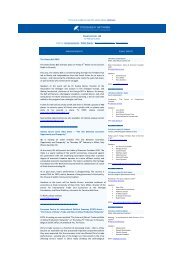An Introduction to Health Technology Assessment - The Stockholm ...
An Introduction to Health Technology Assessment - The Stockholm ...
An Introduction to Health Technology Assessment - The Stockholm ...
Create successful ePaper yourself
Turn your PDF publications into a flip-book with our unique Google optimized e-Paper software.
<strong>An</strong> <strong>Introduction</strong> <strong>to</strong> <strong>Health</strong> <strong>Technology</strong> <strong>Assessment</strong>:<br />
In this second series of A <strong>Health</strong>y Market? publications, the S<strong>to</strong>ckholm<br />
Network will provide a political and economic overview of the current state<br />
of play of health technology assessment (HTA). As a whole, the series will<br />
focus both on the political motivations and economic rationale of HTA.<br />
Among other things, it will highlight the gap between the theory and practice<br />
of HTA, as well as the extent <strong>to</strong> which the HTA process is exercised by the<br />
different national bodies. <strong>The</strong> paper below is an introduc<strong>to</strong>ry definition of<br />
HTA.<br />
From a state-centric point of view, the aim of HTA is <strong>to</strong> provide decision-makers with<br />
more accurate, evidence-based <strong>to</strong>ols for prioritising healthcare treatments in terms of<br />
their utility, efficiency and cost-effectiveness. <strong>The</strong> moral rationale underpinning this<br />
perception is based on the fact that in most developed countries medicines and<br />
treatments are funded <strong>to</strong> a greater or lesser degree by public money (both directly, and<br />
indirectly, such as by tax credits). Thus, the aim of HTA is <strong>to</strong> help governments <strong>to</strong> balance<br />
the need <strong>to</strong> provide the most innovative and cutting-edge healthcare technologies on the<br />
one hand, with the need <strong>to</strong> control the costs associated with such technologies on the<br />
other hand.<br />
In practice, however, it is not at all clear <strong>to</strong> what extent the so called national HTA<br />
bodies - such as the National Institute for <strong>Health</strong> and Clinical Excellence (NICE) in the<br />
UK or the Institute for Quality and Efficiency in <strong>Health</strong> Care (IQWiG) in Germany - focus<br />
on ‘real’ HTA or rather on the mechanistic allocation (some would argue, rationing) of<br />
fixed resources <strong>to</strong> existing healthcare technologies.<br />
<strong>The</strong> political economy of HTA bodies suggests that the structures, processes and political<br />
constructs of different national bodies may have a significant effect on the manner in<br />
which these bodies apply HTA in practice.<br />
Moreover, as will be discussed in future papers, the state-centric approach <strong>to</strong>wards HTA<br />
(aimed at prioritising new medical technologies within cost restraints of governmental<br />
budgets) is subject <strong>to</strong> both ethical as well as practical controversies. Ethical concerns<br />
arise, among other things, due <strong>to</strong> governments’ desire <strong>to</strong> control healthcare costs (and<br />
consequently the rationing of medicines or treatments), possibly at the expense of their<br />
citizens’ health. Practical controversies concern the efficacy and utility of the HTA<br />
process itself.










